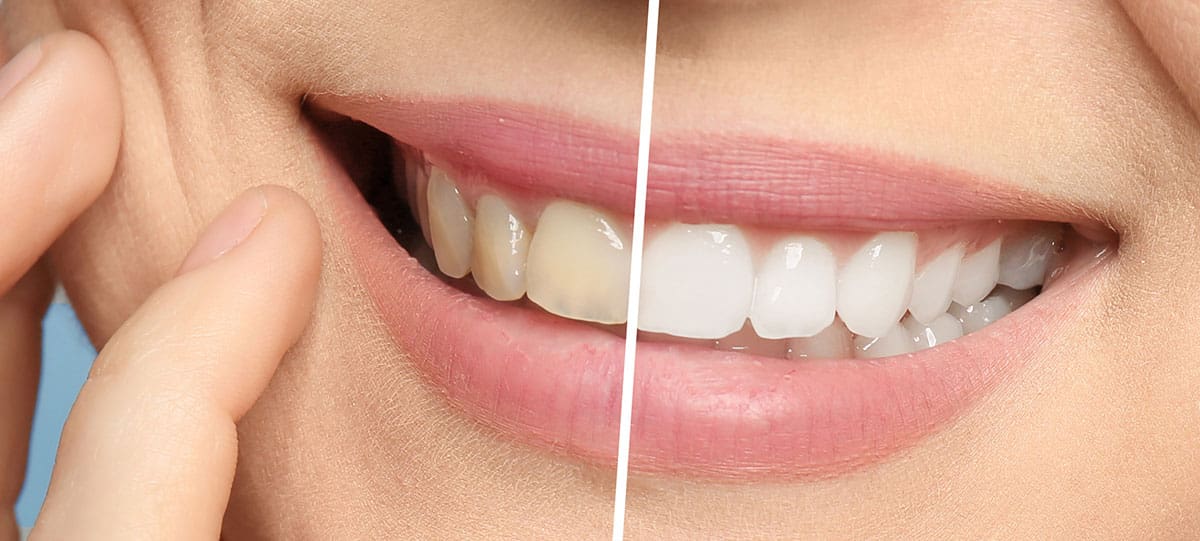Are your teeth looking a little dull and lackluster? Are you self-conscious about your smile? Teeth whitening may be just what you need to brighten up your pearly whites! Whether it’s for an upcoming special occasion or just to boost your confidence, there are plenty of options available for achieving a dazzling smile. From in-office treatments to at-home kits, there’s something for everyone. In this blog post, we’ll explore the ins and outs of teeth whitening, including the best methods and products available on the market. So sit back, relax, and get ready to transform your smile with confidence!
Understanding Teeth Whitening and Bleaching
Teeth whitening and bleaching are two terms that are often used interchangeably, but they actually refer to different processes. Teeth whitening is the process of removing stains and discoloration from the teeth using various methods, while bleaching refers specifically to a process that lightens the natural color of your teeth beyond their original shade.
There are many reasons why our teeth may become discolored over time. Common causes include drinking coffee or tea, smoking cigarettes, consuming red wine or certain foods like berries. Aging can also cause our enamel to thin out, revealing more of the yellowish dentin layer beneath.
When it comes to whitening and bleaching treatments, there are a few things you should know about how they work. Most methods use either hydrogen peroxide or carbamide peroxide as an active ingredient which helps break down surface stains on your tooth enamel.
It’s important to note that not all types of staining will respond well to teeth whitening treatments. For example, if your discoloration is caused by medications like tetracycline antibiotics or excessive fluoride exposure during childhood development then traditional at-home remedies may not be effective in these cases.
Understanding what causes tooth discoloration and how different methods work can help you make informed decisions when it comes time for treatment options.
In-Office Teeth Whitening: Pros and Cons
In-office teeth whitening treatments are a popular choice for those looking to brighten their smile quickly. One of the main advantages of in-office whitening is that it can be completed in just one appointment, making it an ideal option for busy individuals.
During an in-office treatment, a dentist will apply a concentrated bleaching agent to your teeth and use special lights or lasers to activate the product. This process typically takes around 60-90 minutes and can result in teeth being several shades whiter.
However, there are some potential downsides to consider before opting for this method. In-office treatments tend to be more expensive than at-home options and may not be covered by insurance. Additionally, some people experience sensitivity or discomfort during or after the procedure.
It’s also important to note that while in-office treatments offer quick results, they may not last as long as other methods of whitening like custom-fitted trays used with bleach gel or over-the-counter products which you can use at home on your own time.
If you’re looking for fast and efficient results from a professional dental team then an in-office treatment might be right for you – but do your research beforehand!
At-Home Teeth Whitening Options: Which One is Best for You?
When it comes to teeth whitening, there are numerous options available for at-home use. But which one is best for you? Let’s take a closer look.
First up, we have whitening toothpaste. While they may not give dramatic results, they can help to remove surface stains and keep your teeth looking brighter over time with regular use.
Another popular option is whitening strips. These thin plastic strips coated with peroxide gel are applied directly onto the teeth and left for a designated amount of time before removal. They can be effective in removing deeper stains but may cause sensitivity in some users.
Whitening gels, on the other hand, are applied using custom trays that fit over your teeth. This method can provide more even coverage than strips but requires more commitment as it needs to be done regularly over several weeks.
There are LED light kits that claim to accelerate the whitening process by activating the gel or paste used along with them. However, their effectiveness has mixed reviews from users.
It depends on your personal preference and budget when choosing an at-home teeth whitening option that works best for you. Be sure to consult with your dentist before starting any new treatment plan! Also, if you want to learn more about the cost of Dental implants , you can checkout this resource.
The Best and Safest Ways to Whiten Teeth
When it comes to teeth whitening, there are countless options available on the market today. However, not all of them are safe and effective for everyone. If you’re looking for a tried-and-true method to achieve a brighter smile, here are 12 of the best and safest ways to whiten your teeth.
Try using baking soda mixed with water or hydrogen peroxide as a gentle yet effective home remedy. You can also opt for oil pulling with coconut oil or swishing apple cider vinegar diluted in water.
For more immediate results, consider professional dental whitening services such as laser or light therapy treatments. These methods can be pricey but produce noticeable improvements in just one session.
Whitening strips and gels may also be an option for those on a budget or seeking convenience. However, it’s important to avoid overuse which can lead to tooth sensitivity and damage.
Natural products like activated charcoal powder derived from coconut shells have become increasingly popular due to their ability to absorb stains from teeth without causing harm.
In addition, electric toothbrushes paired with whitening toothpaste containing ingredients like fluoride and potassium nitrate can help maintain white teeth while promoting overall oral health.
Avoiding dark-colored beverages like coffee and red wine and quitting smoking altogether will prevent further staining of teeth in the long run while improving overall health outcomes too!
When selecting any product or service for your dental care routine always research thoroughly so that you make informed decisions about what is right for you!
Our Top Picks for at-Home Teeth Whitening Kits
When it comes to at-home teeth whitening kits, the options can be overwhelming. That’s why we’ve narrowed down our top picks for you.
First on our list is the Crest 3D White Whitestrips. These strips are easy to use and provide noticeable results in just a few uses. Plus, they’re affordable and accessible at most drugstores.
Next up is the Glo Science Brilliant Personal Teeth Whitening Device. This kit includes a mouthpiece that emits heat and light to accelerate the whitening process. It may be pricier than other options, but users rave about its effectiveness.
For those looking for a natural option, we recommend the Cali White Vegan Teeth Whitening Kit. Made with organic ingredients like coconut oil and activated charcoal, this kit promises to whiten teeth without any harsh chemicals or sensitivity.
Another popular choice is the AuraGlow Teeth Whitening Kit. This kit includes trays to mold to your teeth for a custom fit and LED lights to enhance results. Users report significant improvement in tooth color after consistent use.
We suggest trying out Smile Direct Club’s Bright On® Premium Teeth Whitening Kit. This kit includes both whitening pens and LED accelerator lights for quick touch-ups on-the-go.
Remember that everyone’s teeth are unique, so what works best for one person may not work as well for another. Experimenting with different at-home whitening kits can help you find what works best for your individual needs and preferences!
How to Naturally Whiten Your Teeth at Home
There are several natural ways to whiten your teeth at home. One of the most common methods is to use baking soda. This ingredient is an effective abrasive that can remove surface stains on your teeth. You can mix it with water and brush your teeth with the paste a few times a week.
Another option is to use hydrogen peroxide, which has bleaching properties that can help whiten teeth. You can create a mouthwash by mixing equal parts of hydrogen peroxide and water, swishing it around in your mouth for 30 seconds before spitting it out.
Apple cider vinegar is also known for its whitening properties. However, you should be careful when using this method because it’s highly acidic and may damage tooth enamel over time. Dilute it with water and rinse your mouth after brushing.
Eating certain fruits such as strawberries or pineapples may also help brighten up your smile due to their high content of malic acid, which acts as a natural stain remover.
These natural remedies aren’t guaranteed to work for everyone but they’re worth trying if you want to avoid harsh chemicals found in some commercial products.
Talking to Your Dentist: Why It’s Important Before Whitening Your Teeth
Before undergoing any teeth whitening procedure, it is important to talk with your dentist. Your dentist can help assess the current state of your teeth and recommend the most effective and safest whitening option for you.
Teeth sensitivity, existing dental work or oral health conditions may affect which method is best suited for you. Furthermore, some over-the-counter products may not be suitable for everyone due to varying levels of peroxide content.
Your dentist can also guide you on how often to whiten your teeth without causing damage or pain. It’s essential to understand that excessive use of whitening products can cause tooth sensitivity and even enamel erosion.
In addition, talking to your dentist before embarking on a whitening journey will ensure that all other underlying dental issues are taken care of first. This includes addressing gum disease or cavities before starting any cosmetic treatment.
Consulting with a dental professional ensures safe and effective results while avoiding potential risks associated with improper use of at-home products.
Maintaining White Teeth: Tips for Everyday Use
Maintaining white teeth is a crucial part of oral hygiene, as it enhances your smile and boosts self-confidence. After investing time and money in whitening treatments, it’s essential to adopt healthy habits that keep your teeth looking bright every day.
One way to maintain white teeth is by avoiding certain foods and drinks that cause staining, such as coffee, red wine, tea, and soda. If you can’t resist these drinks, use a straw to minimize contact with the enamel.
Brushing twice daily with fluoride toothpaste helps remove surface stains while preventing cavities. Flossing once per day removes plaque buildup that causes discoloration between teeth.
Rinsing with water after eating or drinking prevents particles from sticking onto the surface of the teeth. Chewing gum sweetened with xylitol stimulates saliva production which neutralizes acid produced by bacteria in the mouth.
Regular dental check-ups are also critical for maintaining white teeth since dentists can detect problems early on before they become severe issues affecting tooth color. By implementing these everyday tips into your routine consistently, you’ll be able to enjoy a brighter smile for longer!
Professional Dental Whitening Services: What to Expect
If you’re considering professional dental whitening services, it’s important to know what to expect before going in for your appointment. First and foremost, your dentist will evaluate the current state of your teeth and determine if you’re a good candidate for teeth whitening.
During the actual procedure, a protective gel or rubber shield will be applied to your gums to prevent any irritation from the whitening solution. Your dentist will then apply the solution directly onto your teeth and use a special light or laser to activate it.
The length of the procedure can vary depending on how severe your staining is, but generally takes anywhere from 30 minutes to an hour. Some people may require multiple appointments for optimal results.
Afterwards, you may experience some sensitivity in your teeth and gums but this should subside within a few days. Your dentist may also recommend avoiding certain foods or drinks that could potentially stain your newly-whitened smile.
Professional dental whitening services are safe and effective when performed by a licensed dentist. It’s important to follow all aftercare instructions provided by your dentist for best results.
Whitening Toothpaste and Electric Toothbrushes: Fact or Fiction?
Whitening toothpaste and electric toothbrushes have become a popular option for people looking to brighten their smile. But the question remains, are they fact or fiction?
Many whitening toothpastes claim to remove stains and whiten teeth with regular use, but it’s important to note that these products only remove surface-level stains and won’t change the natural color of your teeth.
Meanwhile, electric toothbrushes claim to clean more effectively than manual brushes, potentially leading to brighter teeth. While there is some evidence supporting this claim, it’s important to remember that proper brushing technique is key regardless of what type of brush you use.
It’s also worth noting that while these products may help improve the appearance of your teeth, they should not be used as a substitute for professional dental care. Regular check-ups with a dentist are necessary for maintaining good oral health.
Whether or not whitening toothpaste and electric toothbrushes work as advertised depends on various factors such as individual habits and overall oral hygiene routine. As always, it’s best to consult with a dental professional before incorporating any new product into your routine.
The Pros and Cons of Whitening Strips and Gels
Whitening strips and gels are popular at-home teeth whitening options. They work by applying a thin layer of the gel or strip directly onto your teeth, allowing it to sit for a certain period of time before removing it.
One pro of using these products is that they can be convenient for those on-the-go or with busy schedules. You can easily apply them while doing other activities and get noticeable results in just a few weeks.
However, there are also some cons to consider. One potential issue is sensitivity – the chemicals used in these products can cause discomfort in some individuals, especially if overused. It’s important to follow instructions carefully and not use more than recommended.
Additionally, whitening strips and gels may not provide as dramatic results as professional dental services or even at-home kits with stronger formulas. If you’re looking for quick and drastic changes, this may not be the best option for you.
It’s important to weigh the pros and cons before deciding whether whitening strips or gels are right for your individual needs and preferences. Consult with your dentist if you have any concerns about sensitivity or effectiveness.
Avoiding Dangers: Which Teeth Whitening Methods to Avoid
When it comes to teeth whitening, there are a lot of options out there. However, not all methods are created equal, and some can actually be dangerous for your oral health. Here are some teeth whitening methods that you should avoid:
Be cautious about using over-the-counter bleaching kits without consulting with your dentist first. Many of these products contain high concentrations of hydrogen peroxide which can cause tooth sensitivity and damage the enamel if used improperly.
Charcoal whitening products have become increasingly popular in recent years, but they may do more harm than good. Charcoal is abrasive and can scratch the surface of your teeth leading to increased risk of decay and stain accumulation.
At-home UV light devices may seem like an easy way to whiten your teeth quickly but they also carry risks such as damaging gum tissue or even increasing the risk of oral cancer.
While natural remedies like lemon juice or apple cider vinegar claim to whiten teeth naturally; these acidic substances can erode enamel over time harming both gums and surrounding tissues.
It’s important to remember that when it comes to teeth whitening safety should always come first. Consult with a dental professional before trying any new method or product for best results!
Frequently Asked Questions about Teeth Whitening
Teeth whitening is a popular cosmetic dental procedure that can improve the color of your teeth and give you a brighter smile. With its growing popularity, it’s natural to have some questions about the process. Here are some frequently asked questions about teeth whitening:
What causes tooth discoloration?
Tooth discoloration can be caused by several factors such as aging, smoking, drinking coffee or tea, red wine consumption, and certain medications.
Is teeth whitening safe?
Yes! Teeth whitening is considered safe when done properly under professional supervision or using over-the-counter products that are approved by reputable organizations.
How long does teeth whitening last?
The longevity of teeth whitening depends on how well you take care of your oral health after the treatment. Regular brushing and flossing along with regular cleaning appointments will help prolong the results.
Can I whiten my veneers or crowns?
No. Teeth whitening only works on natural tooth enamel and cannot change the color of restorations like veneers or crowns.
Are there any side effects to teeth whitening?
Some people may experience temporary sensitivity during or after treatment but this usually subsides within a few days.
Can I whiten my teeth if I have gum disease or cavities?
It’s not recommended to undergo any form of teeth whitening until all underlying dental issues like gum disease and cavities are addressed first.
Further Reading for a Healthier, Brighter Smile.
With the information provided in this article, we hope to have given you a better understanding of teeth whitening and the various methods available. Remember that it’s crucial to consult with your dentist before undergoing any treatment. By doing so, you can ensure that the method chosen is safe and appropriate for your dental needs.
Additionally, maintaining good oral hygiene habits such as regular brushing and flossing can go a long way in keeping your smile bright and healthy. As always, further reading on this topic can provide even more insight into how you can achieve a healthier, brighter smile. Happy reading!



































